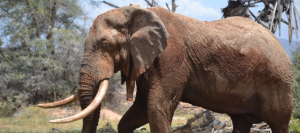Technology solutions for wildlife conservation: How GPS and cell phones are helping to monitor and protect African elephants

© Save the Elephants
The viral spread of smartphones has jumped a species. African elephants are now also benefitting, thanks to new software algorithms developed by researchers and conservationists.
A study published today in the journal Ecological Applications by researchers at the University of British Columbia, Vancouver, Colorado State University, U.S.A. and Save the Elephants, Kenya reports on the use of advanced technology to help monitor and protect African elephants.
The sophisticated tracking system built by the study’s lead author – Jake Wall – collects, analyzes and reports on the movements and activities of nearly 100 African elephants in real-time in an effort to both understand the ecology of movement and also to protect these threatened animals. “GPS, GSM and satellite phone technologies are rapidly becoming the pen and paper of animal field biologists,” says Jake Wall. “The GPS trail of an animal, combined with data from satellite imagery and other remote sensors, can give us a detailed picture of where the animal is, what it is doing and what it might be experiencing.”
The tracking system was developed using Geographical Information System (GIS) software components donated by the Environmental Systems Research Institute (Esri) in California, runs from the Amazon EC2 Cloud – the same cloud servers that power Netflix, and allows real time visualization of animal movements on Google Earth. The technology provides near instantaneous observation of the GPS location of an animal within seconds of it being recorded by an animal’s tracking collar.
Data are transmitted via the Inmarsat satellite constellation or the local cell phone network. The real-time locations reveal patterns of movement while high-resolution satellite imagery provides context for understanding observed behavior. Behind the scenes, a set of sophisticated software algorithms monitor incoming elephant movement datastreams and summarize complex information. One algorithm looks specifically for elephants that become unnaturally immobile – a warning that can indicate that an elephant is in trouble. Poaching of elephants for ivory has emerged once again as a serious threat to the species.
The real-time monitoring system is being applied to identify poaching events. When one occurs and is properly identified by the system, alerts are issued via SMS and e-mail to wildlife management and enforcement allowing rapid response. “Applying technology in novel ways gives managers an edge over poachers, which is increasingly critical to the protection of elephants and many endangered species in the face of increasing sophistication in poaching networks,” says George Wittemyer. “This system is allowing us to change the risks associated with poaching, ultimately enhancing the deterrents to such illegal activities.”
“Tracking of elephants has helped lift the veil on the secrets of elephant lives over the last few decades. This novel integration of smartphone technology has allowed movement data to leap from the realm of applied research into a vital conservation tool that is used daily by anti-poaching forces,” said Iain Douglas-Hamilton, Founder of Save the Elephants.
The real time monitoring system described in the paper has not only served to enhance security for threatened elephants, but also has allowed proactive interventions when elephants enter areas they are unwelcome (such as farmers fields), identified injuries allowing rapid medical response, been used to educate politicians on elephant movement corridors, and inspire school children about science and wildlife conservation. Such technological solutions to the myriad of 21st century threats faced by wildlife are proving to be a critical tool for conservation practitioners.
Contacts:
Jake Wall University of British Columbia Ph: +1-604 723-1224 E-mail: [email protected]
Dr. George Wittemyer – Colorado State University Ph: +1-970 227-5713 Email: [email protected]

